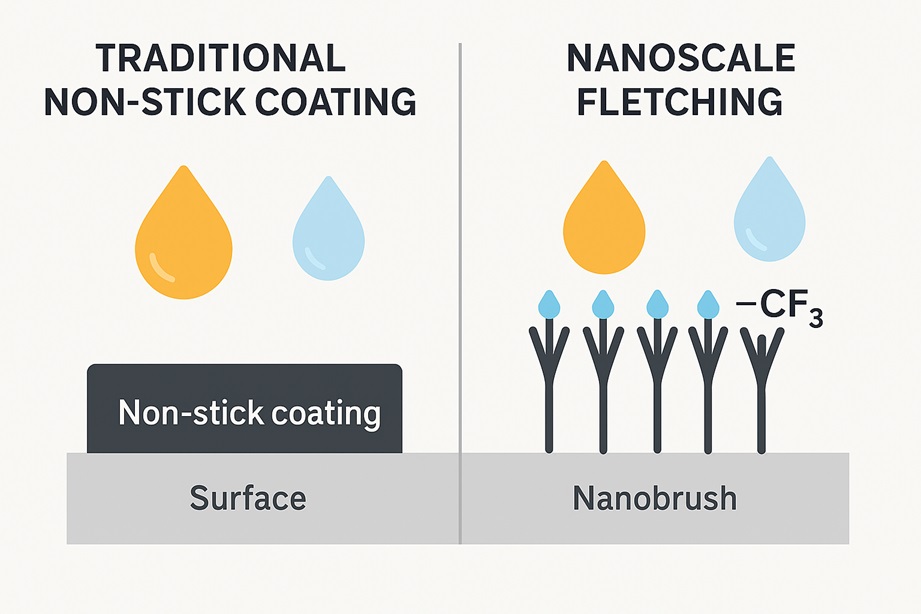Quick Answer: A cutting-edge innovation from the University of Toronto is reimagining non-stick cookware using a technique called nanoscale fletching—a chemical-minimizing, high-performance alternative to toxic Teflon coatings.
What Is Nanoscale Fletching?
Inspired by the aerodynamics of arrow feathers (aka “fletching”), scientists have applied this concept at the nanometer scale. Instead of actual feathers, they’ve built a forest of tiny polymer bristles, each tipped with a single molecule of fluorine — the smallest unit of a PFAS compound.
This creates a surface that mimics the slippery, non-stick behavior of traditional Teflon, but with minimal chemical use and far lower health and environmental risks.

How It Works
The Materials:
- Base Polymer: Polydimethylsiloxane (PDMS), a silicone widely used in medical devices.
- Brush Design: Short chains of PDMS are grafted upright like bristles.
- Tip Chemistry: Only the tip of each bristle contains a single –CF₃ group (one carbon, three fluorines).
The Effect:
- Oil, water, and grime bead up and slide off.
- The nanobrush surface resists adhesion without relying on thick chemical coatings.
- Think of it as molecular-scale armor against stickiness.
Why It Matters: The PFAS Problem
Traditional non-stick coatings—like Teflon (PTFE)—rely on long-chain PFAS (per- and polyfluoroalkyl substances), which are known as “forever chemicals.” These compounds:
- Don’t break down easily in the environment
- Accumulate in the human body
- Are linked to cancer, hormonal disruption, and liver damage
The Challenge: Create a slick surface without these toxic substances.
✅ The Solution: Nanoscale fletching reduces PFAS content to the lowest practical level—just one carbon’s worth of fluorine per bristle tip—while maintaining performance.
How Eco-Friendly Is It?
| Feature | Traditional Teflon | Nanoscale Fletching Coating |
| PFAS Chain Length | Long-chain (C8+) | Shortest possible (C1) |
| Risk of Leaching | High at high heat | Extremely low |
| Biodegradability | Non-biodegradable | Silicone base is inert |
| Environmental Impact | Significant | Drastically reduced |
While not completely PFAS-free, this innovation cuts PFAS use to a mere fraction, eliminating the need for thick, chemical-laden coatings.
Performance: Does It Match Teflon?
Yes—and in some lab tests, it actually outperforms standard non-stick coatings:
- Oil Repellency Score: Rated 6 on the AATCC scale (on par with commercial-grade coatings)
- Durability: Resistant to heat and abrasion
- Food Release: Comparable slipperiness to Teflon under test conditions
note: All the non-stick benefits with radically less risk.
Is It Available in Stores Yet?
Not yet. As of mid-2025, the nanoscale fletching non-stick technology is still in the research and development stage.
- The innovation comes from the University of Toronto’s DREAM Lab, led by Professor Kevin Golovin.
- The team is actively seeking commercial partners to help scale and adapt the coating for mass production.
- No consumer cookware or commercial products using this exact technology have been released—yet.
Estimated Commercial Timeline: Still unknown. Like most scientific breakthroughs, real-world application could take several years depending on manufacturing feasibility and safety approvals.
Where You’ll See It First (Eventually)
Once commercialized, this technology could transform:
- Frying pans and saucepans
- Bakeware and oven liners
- Restaurant cookware and food-grade surfaces
- Non-stick textiles and packaging
It’s a platform technology with broad potential—not just for kitchens.
Who Invented It?
This breakthrough was pioneered by Professor Kevin Golovin and PhD researcher Samuel Au at the University of Toronto’s Department of Materials Science & Engineering.
Their research, published in Nature Communications (2025), could lead to a new generation of non-stick cookware that avoids the legal, environmental, and health controversies of Teflon.
Potential Beyond the Kitchen
Nanoscale fletching could soon impact:
- Medical tools that resist contamination
- Oil-resistant fabrics
- Water-repelling construction materials
- Industrial machinery prone to fouling
It’s a platform, not just a coating.
The Fine Print: Not Entirely Chemical-Free
Let’s be clear: This isn’t completely PFAS-free.
But it’s a significant leap forward in safe chemical engineering:
- Uses the shortest PFAS molecule available (C1)
- No long-chain PFAS like PFOA or PFOS
- Designed to be non-leachable and stable
✅ It’s a cleaner alternative, not a greenwashing gimmick.
Key Takeaway
Nanoscale fletching is more than a buzzword—it’s the beginning of a safer, smarter era of non-stick innovation. By combining molecular design with environmental responsibility, scientists have achieved a near-Teflon experience without the PFAS baggage.
Teflon vs. Nanoscale Fletching
| Feature | Traditional Teflon | Nanoscale Fletching |
| Chemical Content | High PFAS | Minimal PFAS (C1) |
| Health Risk | Elevated | Very Low |
| Repellency | High | High |
| Bioaccumulation Risk | High | Negligible |
| Commercial Availability | Yes | Not Yet |
What’s Next for Nanoscale Fletching?
As public demand grows for non-toxic, high-performance cookware, researchers are pushing nanoscale fletching beyond the lab. The next steps include:
- Scaling production methods for real-world surfaces
- Adapting the coating to be fully PFAS-free
- Testing durability under long-term kitchen conditions
- Exploring broader uses in medical devices, food packaging, and protective fabrics
If successful, this technology could mark the beginning of a new era—where slippery doesn’t have to be synthetic, and convenience doesn’t compromise health.
Manufacturers and eco-conscious brands are now being invited to collaborate with the inventors, potentially accelerating commercialization across multiple industries. The dream? A future where every non-stick surface is safer by design—right down to the molecules.
Final Thoughts
We’ve long relied on coatings like Teflon to simplify our lives, but they’ve come with invisible costs—chemical exposure, environmental buildup, and long-term health risks. Nanoscale fletching introduces a fresh, scientifically sound solution that proves we don’t need to choose between performance and safety.
While you can’t buy these pans just yet, their arrival could be just around the corner. For now, nanoscale fletching serves as a glimpse into a smarter, greener future—where every scratch-resistant pan is also people-safe and planet-friendly.
Science is rethinking your skillet. Are you ready for it?


